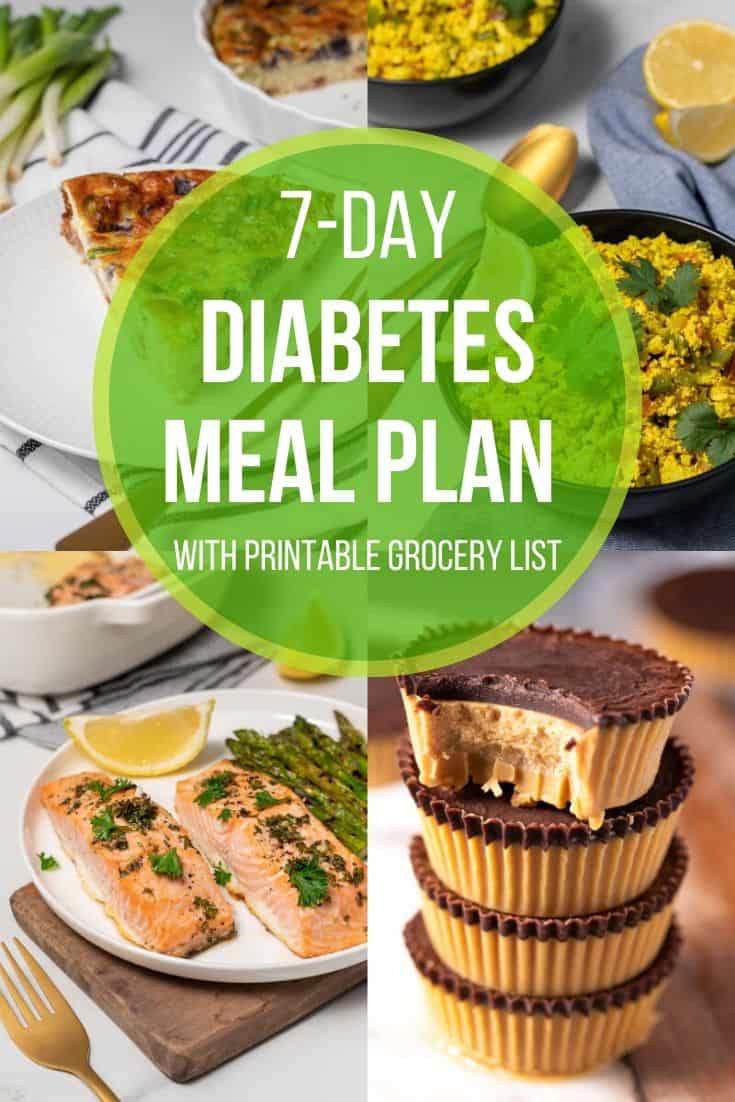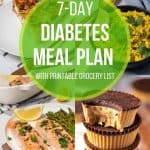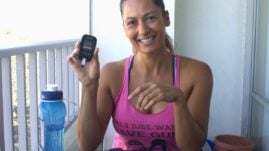This 7-day diabetes meal plan will give you an easy-to-follow plan for what and how much to eat to get the healthy nutrition you need as a person living with diabetes.
Equally importantly, all the food in this meal plan tastes great and motivates you to stick to the plan!
It includes instructions on how to find your daily calorie needs and adjust the meal plan to your goals (weight loss, maintenance, weight gain, etc.)
To make following the plans easier, it also includes a downloadable grocery list and a day-by-day overview that you can print out and put on your fridge or bring grocery shopping.
All of the recipes are low-carb so they fit the nutrition preferences of most people living with diabetes.
If you prefer a meal plan with even fewer carbs, you can follow our Ketogenic Meal Plan instead.

What is a good meal plan for people with diabetes?
A good diabetes meal plan is one that provides you with all the healthy nutrition you need while helping you keep your blood sugar level in your target range.
According to the American Diabetes Association’s 2019 nutrition guidelines, there are many different ways to create a healthy diabetes meal plan, but there is “growing evidence to show that low-carbohydrate eating patterns can benefit people with diabetes and prediabetes.”
This plan is what many will consider “moderately low carb” which means:
- Less than 25 grams of carbohydrates in each meal or snack
- Protein and healthy fats in every meal
- Plenty of fiber to aid digestion and help manage blood sugar levels (by slowing down the absorption of carbohydrates)
- No processed carbohydrates or added sugars
- Limited natural sugars (from fruit, etc.) that can cause blood sugar spikes
- Moderate in sodium
Of course, no meal plan will perfectly suit everyone. You may have specific dietary needs or food allergies to take into account or simply like different foods than what’s included in this plan. If so, use this plan as a starting point and substitute the meals that don’t work for you with something else with similar macronutrients.
How to find your daily calorie need
We all have different calorie needs. Your daily calorie need depends on your size, fitness level, daily activity, gender, etc.
When you are creating a healthy diabetes meal plan, your first step should therefore always be to calculate your “calorie equilibrium”, or how many calories you need each day to maintain your current weight.
You can learn exactly how to find your calorie equilibrium with 5 easy steps in this post: “How to Find Your Daily Calorie Need“.
Once you know your calorie equilibrium, you can adjust your daily calories up or down to meet your goals. If your goal is to lose weight, I recommend that you eat up to 500 calories less than your equilibrium each day (but no less than 1,200 per day). This should lead to a steady and healthy weight loss.
If you want to build more muscle mass (or just gain weight in general), start by eating 300-500 calories more than your equilibrium each day and see what happens. If you find that you are putting on a little too much fat, decrease your calories slightly.
How to use the meal plan
This is a 1600-calorie meal plan that can be adjusted to whatever number of daily calories you choose.
The meal plan has 3 main meals and 2 snacks per day and it tells you how many calories and carbohydrates are in each meal and snack.
If you need to adjust the calories, start by adding or removing a snack. If that isn’t enough to reach your calorie goal, adjust the servings of one or more main meals.
Vegetables are included as a separate line for each day but it’s recommended to split them up so you eat some vegetables with each main meal (or at least lunch and dinner). Vegetables are also great for grazing on throughout the day to keep hunger at bay.
Vegetables in this plan mean low-carb veggies like salad, broccoli, cucumber, etc. NOT carbs like beans, potatoes, etc. You can see a list of great low-carb veggies at the end of this post.
You can download a day-by-day overview of the meal plan HERE and print it and hang it on your fridge (or just keep it on your computer or phone) so you always know what to eat next.
Food prep and cooking
To make your meal prep for the week a little easier, you can find a downloadable and printable grocery list HERE that includes everything you need to make every meal.
Many of the meals can be made in large batches and stored in the fridge. Some meals are included on multiple days so you can cook for several days at the same time so always check the day-by-day plan before you start meal prepping.
7 -Day Diabetes Meal Plan
Day 1
Breakfast: 4 Egg Muffins (352 calories & 8 g carbs)
Snack: 5.2 oz (148 g) Greek yogurt (0%) + 1 oz. (28 g) almonds (248 calories & 12 g carbs)
Lunch: 1 serving Salad Niçoise (405 calories & 18 g carbs)
Snack: 3 oz. (85 g) shelled edamame (120 calories & 8 g carbs)
Dinner: 1.5 serving Quiche (401 calories & 10 g carbs)
Veggies: 20 oz. (4-5 cups, 570 g) vegetables enjoyed throughout the day – estimated 80 calories & 20 g carbs
Total: 1607 calories & 76 g carbs
Day 2
Breakfast: 4 Egg Muffins (352 calories & 8 g carbs)
Snack: 4 oz. (114 g) apple + 1 tsp. nut butter (155 calories & 20 g carbs)
Lunch: 1.5 serving Quiche (401 calories & 10 g carbs)
Snack: 2 servings Cottage Cheese Parfait with Berries (250 calories & 25 g carbs)
Dinner: 1 serving Rosemary Chicken (Tuscan Style) + 1 serving Cauliflower Mash (375 calories & 14 g carbs)
Veggies: 20 oz. (4-5 cups, 570 g) vegetables enjoyed throughout the day – estimated 80 calories & 20 g carbs
Total: 1613 calories & 97 g carbs
Day 3
Breakfast: 1.5 serving Cauliflower Oatmeal + 2 eggs (353 calories & 25 g carbs)
Snack: 4 oz. (114 gram) hummus (200 calories & 17 g carbs) Tip: Enjoy with some of the daily veggies
Lunch: 1 serving Peruvian Chicken Wrap (375 calories & 16 g carbs)
Snack: 5 oz. (143 gram) Shelled edamame (200 calories & 14 g carbs)
Dinner: 1.5 serving Mustard Baked Chicken Tenders + 3 oz. (86 g) cooked quinoa (382 calories & 21 g carbs)
Veggies: 20 oz. (4-5 cups, 570 g) vegetables enjoyed throughout the day – estimated 80 calories & 20 g carbs
Total: 1590 calories & 113 g carbs
Day 4
Breakfast: 1 serving Chia Seed Pudding (201 calories & 23 g carbs)
Snack: 4 oz. (114 gram) apple + 1 tsp. nut butter (155 calories & 20 g carbs)
Lunch: 1 serving Peruvian Chicken Wrap (375 calories & 16 g carbs)
Snack: 2 Sugar-free Chocolate Chip Cookie (330 calories & 19 g carbs)
Dinner: 1 serving Salmon with Lemon Butter + 3 oz. (86 g) cooked quinoa (439 calories & 17 g carbs)
Veggies: 20 oz. (4-5 cups, 570 g) vegetables enjoyed throughout the day – estimated 80 calories & 20 g carbs
Total: 1580 calories & 115 g carbs
Day 5
Breakfast: 1 serving Chia Seed Pudding + 2 eggs (345 calories & 24 g carbs)
Snack: 5.2 oz (148 g) Greek yogurt (0%) + 1 oz. (29 g) almonds (248 calories & 12 g carbs)
Lunch: 1 serving Salmon with Lemon Butter (400 calories & 14 g carbs)
Snack: 1 Sugar-free Chocolate Chip Cookie (165 calories & 9 g carbs)
Dinner: 1.5 serving Turkey Chili (348 calories & 25 g carbs)
Veggies: 20 oz. (4-5 cups, 570 g) vegetables enjoyed throughout the day – estimated 80 calories & 20 g carbs
Total: 1586 calories & 104 g carbs
Day 6
Breakfast: 1 serving Protein Pancakes + 2 tsp. nut butter (372 calories & 24 g carbs)
Snack: 1 serving Keto Peanut Butter Fat Bombs (247 calories & 3 g carbs)
Lunch: 1.5 serving Turkey Chili (348 calories & 25 g carbs)
Snack: 1 Sugar-free Chocolate Chip Cookie (165 calories & 9 g carbs)
Dinner: 1.5 serving Zucchini Lasagna (366 calories & 18 g carbs)
Veggies: 20 oz. (4-5 cups, 570 g) vegetables enjoyed throughout the day – estimated 80 calories & 20 g carbs
Total: 1578 calories & 100 g carbs
Day 7
Breakfast: 1 serving Cottage Cheese Pancakes + 1 tsp. nut butter (300 calories & 23 g carbs)
Snack: 5 oz. (143 gram) Shelled edamame (200 calories & 14 g carbs)
Lunch: 1.5 serving Zucchini Lasagna (366 calories & 18 g carbs)
Snack: 1 serving Keto Peanut Butter Fat Bombs (247 calories & 3 g carbs)
Dinner: 1.5 serving Tofu Scramble (Vegan) (357 calories & 25 g carbs)
Veggies: 20 oz. (4-5 cups, 570 g) vegetables enjoyed throughout the day – estimated 80 calories & 20 g carbs
Total: 1550 calories & 103 g carbs
Changing up the plan
If there’s a recipe in the plan you don’t care for, you can easily mix it up by picking other recipes from our recipe library. Simply choose recipes with similar calories and carbohydrates to those included in the plan above.
List of low-carb vegetables
This is, of course, not a comprehensive list of every low-carb vegetable in the world, so if your favorite vegetable isn’t on the list, look up how many carbs are in it yourself (just Googling it works for most vegetables).
- Arugula
- Asparagus
- Bamboo shoots
- Bok Choy
- Broccoli
- Cabbage
- Cauliflower
- Celery
- Cucumber
- Eggplant (aubergine)
- Fennel
- Kale
- Leeks
- Lettuce (all sorts)
- Mushrooms
- Peppers
- Pumpkin
- Radish
- Spinach
- Tomato
- Watercress
- Zucchini (Courgette)
Frequently Asked Questions
Q: Is this meal plan suitable for both type 1 and type 2 diabetes?
A: The 7 -Day Diabetes Meal Plan is suitable for people living with any type of diabetes unless your medical team has recommended you follow a specific different diet. Always defer to the guidance of your medical team. The plan is moderately low-carb but per the American Diabetes Association’s 2019 nutrition guidelines, the appropriate daily carbohydrate intake is personal, so please adjust accordingly.
Q: I practice intermittent fasting. Can I combine meals or skip snacks so I can eat everything in the 6-hour window where I don’t fast?
A: Yes, you can enjoy the meal plan and still practice intermittent fasting. Feel free to combine meals or skip snacks as long as you still eat enough calories to support your goals
Q: What do I do if I can’t follow the meal plan for every meal (because of work, social life, etc.)?
A: That’s OK, the meal plan is meant to make life easier, not harder. Try to match the daily calories and carbohydrates as close as you can but don’t stress too much about it.
Q: What if I’m allergic or don’t like some of the ingredients?
A: No worries, just substitute the ingredients you don’t want or simply make a different meal. Just try to match the calories and carbohydrates listed for the meal you don’t want
Q: What if I don’t cook?
A: Eating healthy can be done even if you don’t cook. Try choosing food options that match the daily calorie targets as a minimum. When you buy food at restaurants or pre-cooked at the supermarket, pay attention to how it’s prepared and try to look the food up online to help you with carb counting
Q: Can I continue using this meal plan after the first week?
A: Yes, you can use this meal plan until you grow tired of the meals. And when you do, simply substitute the meals for others in our recipe library or your own favorite recipes






Mary
My doctor told me my A1C is 6-1, pre- diabetic
I am tall and slim . I don’t want type 2 diabetes.
Yet I would like to keep my weight and gain 10 pounds
I find with the low carb diets & protein their focus on losing weight
I do not need to Lose any weight. Are there low carb weight gain shakes.
Christel Oerum
You can gain weight on low carb diets. In regards to weight loss or gain, you need to focus more on your overall caloric intake. For muscle gain, make sure you’re in a small surplus and start lifting weights
Sue H.
Just wondering about the amount of meals a day… so you eat 6 meals a day? If my daughter eats a snack at bedtime, her bg always goes high during the night… it’s a struggle.
Christel Oerum
It’s smaller meals so yes I do eat 6 a day. You can also see it as 3 main meals and 3 snacks. I find it harder to manage my blood sugars when I spread my meals out. My nighttime snack is usually not super carb heavy and if it is it’s very low on fat (so it won’t haunt me all night long). It doesn’t work for everyone but for those who are hungry at night, I always recommend eating a small meal/snack rather than ending up snacking on everything. If you decide that’s not the right solution for your daughter you can have that last meal as dessert or add it to another meal
Neeraj
Hi my sugar was 600 diagnosed around 2 year back. I have been struggling for 2 year with my diet. I was weighted 73 kg now I am only 63. I look so lean I want to put on weight again with controlling my sugar. What diet plan should I follow?
Christel Oerum
Hi Neeraj,
I’d recommend you determine your calorie need and make sure you eat enough (Read how to do that HERE). If you want to put on muscles you’ll also need to start resistance training.
Marisela
I just recently (this week) was diagnosed with type 2. My A1C was
6.7.
I’ve been eating small amounts of chocolates sugar free pudding with Lactose milk, divided into 6 portions with whipped cream.
It curbs my cravings and I’m almost through the detox stage.
The pudding itself has no sugar and 8 carbs four 4 servings. The milk has 12 sugars and 24 carbs.
Is this ok to eat as a snack?
Thank you!
Christel Oerum
If those snacks help you, then yes. I can’t, however, tell you whether it’s too many sugar carbs for you, that will depend on the guidelines you have been given by your medical team. I like to keep my meals and snacks below 30 g or carbs and it sounds like you are way under that.
One way to test if this is right for you is to test your blood sugar ~2 hours after your snack and see where you’re at
Mehak
How can i reduce my insulin
Christel Oerum
Why do you need to would be my first question? Insulin is what keeps us alive regardless if you live with diabetes or not….
That being said, improving your insulin sensitivity through exercise (resistance training is first priority here) and reducing your carbs will reduce the overall insulin need
Amanda
Hi Christal,
I’m a type 1 nearly 16 years, got it while I was 12 weeks pregnant and 27 years olds, but unfortunately I was originally treated as a type 2 diabetic up until 2 years ago, till they finally did the proper tests and realised I’m a type 1, luckily they had me on insulin all along. So I’m only now learning about carb counting .My A1C is 8.2 and going up all the time, I literally have no energy or motivation to do anything but sleep, I feel like I’m going to hit a brick wall soon, any ideas of a good starting point? I’m nearly 43 and feel like I’ve literally wasted the last 16 years of my life to diabetes.
Love your articles, your amazing.
Christel Oerum
Hi Amanda, it’s really uphill when they can’t even get the diagnosis right.
If all your other blood work is normal you might not be getting enough insulin (aka energy). I remember that feeling from before I got diagnosed. Key would be to work with your medical team (+ your friend Google) to get your basal rate and carb ratios right so that you’re not running high (and without enough gas in the tank). If it will be a while before you see your team I would start by figuring out your carb ratios, if you’re self-managed this is something you can start on your own, and if you’re not collecting enough data on how different foods impact your blood sugar will help your team help you.
You can do this! It will take a little time, and none of us gets it right every time, but as you learn you will start to feel more confident
MARIA ORTIZ
HI MY NAME IS MARIA.MY A1C IS 11 I’M IN SO MUCH MEDS FOR IT.IT SEEMS THAT I’M DOING SOMETHING VERY WRONG.WHAT CAN I DO TO LOWER IT.PLEASE HELP ME.THANK YOU FOR YOU’RE LETTERS.
Christel Oerum
Hi Maria,
I can hear you’re struggling. I’d suggest you start with having an upfront conversation with your medical team on how you can get to a place where you’re happier and in a health situation you’re happy with. If you don’t feel ok or in control, push them to get the support you need.
We, of course, also have a responsibility for our own health and you’ll have to assess whether adding more activity to your day or maybe making changes to your diet can help you down the path you want to go.
Tammy
Hi my name is Tammy im trying to keep my sugar down but it goes up to 300. Does coffee make your sugar go up
Christel Oerum
Hi Tammy,
Yes, coffee can make your BG rise. If you then combine it with Dawn phenomena your BGs can go climbing. Add milk or sweeteners and your BG might skyrocket.
The solution can be to take meds with your coffee, push it to later in the day (when you have fewer hormones to deal with), or cut it out.
Habib Alam
Being Asian I prefer chapati/bread at lunch and dinner what you advise in the morning I take brawn bread slice with fried white egg tea butter sugar free jam 1 table spoon
Mariyam
Use whole wheat ata and eat a bowl of fresh salad .. the fibre will reduce the absoprption of carbs in roti so net glycaemic effect of roti is reduced .. try avoiding too much fat in ur curries too
maria vedoy
need to get a1c lower and I can seem to do it
I love foods, but foods that do not help
Christel Oerum
Maria – you can do it!!!
The beauty of the recipes you’ll find on TheFitBlog is that they will satisfy your taste buds and not make your BG skyrocket. You can eat well and have great A1C.
Buck
Thanks for sharing, Christel. You are inspiring me to get cracking on my workouts. It is very helpful to see what a very active T1 eats. Although everyone is different, having at least an idea how someone’s diet looks can be reassuring to someone getting started with serious exercise. A bonus is that the food sounds great!
Christel Oerum
Thanks Buck, I really appreciate the feedback.
You are so right we are all different, and my meal plan will also differ depending on what/how I exercise. But really glad you found it informative
JO SMITH
I would like a meal plan for two weeks for a Type 1 Diabetic. I want to keep the calories at 1200 or less daily. Also, I would like a chart for low carb vegetables including protein (if any),total calories and fiber. Thank you, Jo (jsmith197@gvtc.com)
Christel Oerum
If you download the PDF of the meal plan you’ll see a 1200 calorie version of the plan including macros (protein, carbs and fats). We don’t have a vegetable list